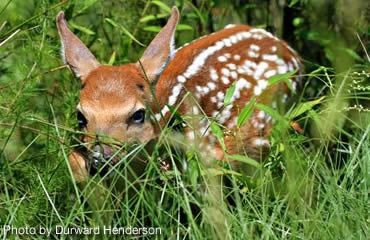Recently, Young Bucks readers were advised to NOT rescue new born wildlife they encounter in the woods.
You may think you’re saving a fawn, but you don’t realize there’s an adult nearby, and what you’re actually doing is harmful.
Here, wildlife biologist Steve Bryant with Alabama Division of Wildlife and Freshwater Fisheries offers a complete explanation of the early life of fawns.
Every animal has physical characteristics that protect it in its native environment, and the white-tailed deer is a perfect example.
When a fawn is born, its coat is reddish brown with white spots covering the body. There are two rows, each containing 60 to 80 spots, one on each side of the spine. The neck, shoulders, sides and flanks are also covered with approximately 100 irregularly sized, randomly scattered white spots. The hair of the spots is not white to the roots but is white-tipped. As the fawn ages, the white is gradually worn away so that the spots begin to disappear before the molt into winter fur.
White-tailed does tend to their newborns in a manner that maximizes their survival.
Immediately prior to birthing, the doe reduces her home range to a small acreage. In a secluded spot with adequate cover, she lies down to give birth. Usually, the fawn is born and licked clean within 30 minutes. The mother will eat all birth by-products to minimize odors that may attract predators. The fawn will stand and nurse soon after birth.
Because body fluids from the birth process have soaked into the leaves, the doe leads the fawn away from the birthing area as soon as it can walk. If two fawns are born, they are usually kept at separate locations.
 During the first month, the doe will actively exclude other deer from her constricted home range. For the first four to seven days, the doe will nurse the fawns four to six times in 24 hours with each feeding lasting around 10 minutes.
During the first month, the doe will actively exclude other deer from her constricted home range. For the first four to seven days, the doe will nurse the fawns four to six times in 24 hours with each feeding lasting around 10 minutes.
For the first week, the fawn primarily remains hidden and still. Fawns usually do not attempt to follow the doe; however, observers have seen does force fawns to lie down with a head or foot. The fawn may be moved to new locations but still remains hidden. The spots on a fawn play an important role as the fawn hides. When lying still, the fawn blends in well with the dappled spots of sunlight filtering through the leaves onto the brown forest floor.
Spotted fawns up to four days old will lie down if discovered. It is theorized to be a fright response similar to the one seen in humans where you are too terrified to move.
Sometimes good-willed humans kidnap fawns because they mistakenly think the young animals are orphaned. Never pick up a fawn that appears abandoned—it usually isn’t. After five days, most fawns begin fleeing from danger.
Fawns normally gain 10 percent of their body weight per day for the first week and then 5 percent of their body weight per week thereafter. When a fawn is nursing, the doe constantly licks the youngster, concentrating near the tail. The mother also eats the fecal material of the fawn to help eliminate odors near it.
After one week, the doe begins to reduce the number of feeding periods and remains in the general area but not as close to the fawn when she is not nursing it. Fawns will begin to wander and the doe either trails the fawn, or if the scent is too weak, will vocalize a soft cat-like mew to call the fawn to return. An endangered fawn will bleat similar to the call of a goat to alarm the mother.
Fawns begin to eat vegetation and ruminate at around two weeks and are dependent on rumination at five weeks. During this time, the doe spends increasingly more time with the fawn. The fawn also begins playing after nursing.
Usually this involves darting and running in a circle about the mother. Month-old fawns run 50- to 100-yard circles around the doe. Play occurs throughout summer, decreases in fall and ceases by winter. Most fawns are completely weaned at 10 to 12 weeks of age.
– Photo courtesy Kate Pugh, Alabama Department of Conservation & Natural Resources.
– Photo courtesy Durward Henderson, Alabama Department of Conservation & Natural Resources.